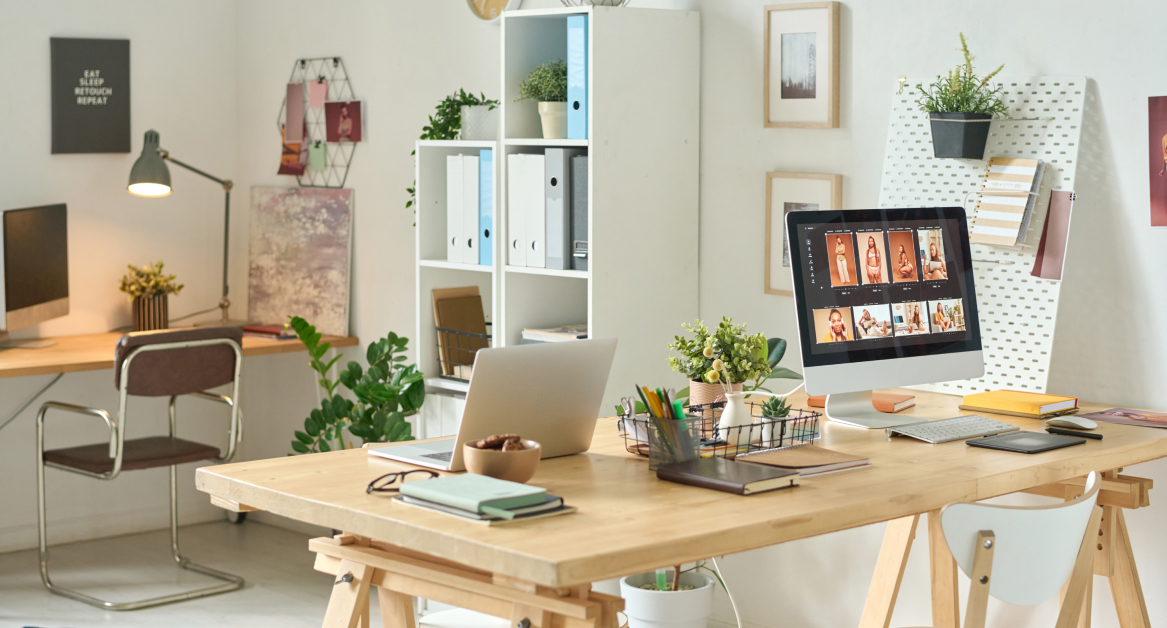Many of us are currently working off our dining table or sofa, wondering whether we’ll be called back to the office soon.
But each day we endure this bad setup is an additional day we risk suffering a repetitive strain injury (RSI).
A good work setup need not be expensive, but suffering an RSI certainly is. In this article we will show you some top home office setup idease for effective remote work – without burning a hole in your wallet!
Understanding the psychology of working from home
To work effectively from home, we have to realize that it is not just about having an ergonomic workspace.
It’s also about understanding the pressures that we face when we work remotely, and creating a workspace that helps in that.
Occupational health psychology tells us that working from home requires a ton of self-control because, unlike offices, homes are not set up to effectively engage in work.
If you don’t set proper boundaries, you could become exhausted from resisting distractions from kids, pets, Netflix or even household chores. This can deplete your mental energy level and cause you to feel tired.
On the other hand, how you configure your home office can positively impact this self-control.
We have compiled a list of to-dos to set up a home office space that helps you stay focused, productive and comfortable all day long:
1. Find a dedicated workspace (or workspaces!)

Many of us in Singapore do not have the luxury of a dedicated study. So we make do by working from our sofa, coffee table or even bed.
But mixing up your work with the area in which you relax is a bad idea.
First, it makes it hard to psychologically disconnect between work and rest. Associating an area like your bed with work will make it hard to unwind during the night. And this is proven by research – using your bed as a make-shift work area disrupts your sleep schedule and makes you less productive.
Second, your bed and sofa are not set up for work ergonomics. A proper workspace should keep your spine in a neutral posture, and enable your head, arms and back to be in a neutral position.
A bed or sofa not only makes this difficult, it also discourages you from moving. This will lead to aches and pains very quickly.
To get a dedicated workspace, you don’t need to construct an entire new study for yourself. Instead, we encourage you to find a space in your home that you can fit a workspace into. Note that by “workspace” we mean both a proper (if small) desk and ergonomic chair – it’s hard to compromise on this.
This space can be a spare corner, an unused wall or some other places you never thought to explore. Some ideas include an area in your bedroom that you can block off with drapes when not in use, a narrow desk along the hallway or a spare corner of your living room.
2. Get yourself an ergonomic chair
Everyone typically spends a lot of time sitting when we work. Yet, sitting is a posture that places a lot of stress on our spines.
To avoid developing back problems, it’s a good idea to invest in an ergonomic office chair that promotes good posture and supports your lower back.
When a chair is properly fitted to you, you will find that:
- you can sit with your feet flat on the floor, your knees bent at a 90 degree angle and your lower back supported; and
- your forearms can be parallel to the ground and your arm and wrists are fully supported.
You don’t need an expensive chair to achieve this, but at a minimum these are what you should look for:
- Adjustable seat height.
An office chair with adjustable seat height from about 40-54cm should fit most people. Make sure that you can place your feet flat against the floor. - Seat width and depth.
The seat should be wide and deep enough to support you comfortably. Try resting your back against the backrest. There should still be a 5-10cm from the back of your knees to the seat pan. Without this gap, you may feel pressure at the back of your knees when you sit. - Adjustable backrest lumbar support.
The chair should have a lumbar adjustment so that you can support the natural “S” curve of your lower back. Without this, you will tend to slouch as you work. - Adjustable backrest.
The backrest should be adjustable forwards and backwards, and have a locking mechanism to secure it in place. - Adjustable armrest.
The armrest should be height adjustable to allow your elbows and lower arms to rest comfortably. This will help to reduce tension from your shoulders and upper body. - Swivel wheels.
The chair should be on swivel wheels so that you can reach objects around your workspace easily. - Materials.
This is a subjective matter. While some users prefer mesh seats due to its breathability, others prefer fabric cushioned seats due to its durability.
If you are willing to look beyond brands and are spend some time to ensure your pick has the above features, you can find plenty of choices on the market.
At Esevel we curate chairs for their ergonomics and offer a unique lease-to-own proposition. This reduces your upfront cost when you set up a home office space, and allows you to try out the fit before you purchase.
3. Consider a healthy standing desk or sit-stand converter
While working from home brings about many benefits, it also reduces your opportunity to move.
After our alarm goes off, many of us just move straight from the bed to our desk.
So when you work remotely, it’s important to make sure you incorporate as much activity into your work day as possible.
A simple solution is to get a standing desk. A standing desk or converter helps you to alternate between sitting and standing easily, without interfering with your work.
There are also other health benefits of standing desks such as better posture and improved metabolic health.
If you already have a desk, you can opt for a standing desk converter to transform your existing desk into a standing desk.
You may think that standing desks or converters are expensive. And you’re right, a quality one can be if you were to purchase them outright.
However, you can also choose a lease-to-own option like Esevel which provides both standing desks and converters on a flexible subscription, with the option to buy it out at anytime.
Alternatively, you can even create your own makeshift standing desk by piling books or stacks of paper to the proper standing height for yourself. But when you do this, make sure you have a corner in which you can still sit to work.
4. Desk setup idea: Get the right ergonomic accessories
By ergonomic accessories, we mean items like laptop stands, document holders, monitor arms, footrest, ergonomic keyboard and mice and the like.
Ergonomic accessories are important – properly used, they can help you improve your posture and keep your body in a neutral posture.
Consider the following 3 accessories:
- Laptop stands:
Laptops are inherently unergonomic for long hours of work. They force you to trade-off between having the screen at your eye level or having the keyboard at your elbow level. A laptop stand solves this problem by elevating the screen to your eye level, you can type on a separate keyboard and mouse with your elbows at 90° angle. - Monitor arms:
A monitor arm can help you bring the screen to the right height for your eyes, and allows you to adjust the height, depth and angle of the screen to get it into the most comfortable position for yourself. When you work staring at the screen for 8 hours a day, this adjustability becomes very important for your comfort. - Additional screen:
The advantage of having a second larger screen is that it not only gives you a bigger and better viewing experience, but it also allows you to increase your productivity by 20-30%. You can leave one screen to reference critical information while utilizing the other one for your actual work. You can even run multiple applications simultaneously instead of having to switch between applications.
Extra tips: With all these devices running on your desk, consider getting a power strip to plug in all the wires, thus making your desk clean and organized.
The key with ergonomic accessories is to know exactly what you need.
If you are a heavy screen user, a dual monitor may be very useful for you. But if you prefer just working off your laptop, a laptop stand and an external keyboard and mouse may be more useful.
5. WIFI: options to speed up your home WiFi connection
If you are working remotely and have a patchy WiFi, this can be a serious impediment to your productivity.
According to a survey by Whistleout, over one-third of remote workers said that a poor internet connection has prevented them from doing their work at some point. Of these, 65% said they’ve had their video calls cut, freeze or disconnect.
So if you have experienced WiFi issues in the past, it’s a good idea to troubleshoot your Internet connection when you set up a home office space.
There are many expensive options of troubleshooting your Internet connection including getting a better (cue more expensive!) router or WiFi extenders.
But we recommend just starting off by doing a simple speed check and router reboot to make sure everything is working fine.
If you are still having trouble with your WiFi, a cheap fix to get a faster connection is just to connect your laptop to the physical LAN.
If that’s not an option and you prefer having an expert to troubleshoot for WiFi for you, or if your work demands speedy and uncompromised Wifi connectivity, consider the Esevel Wifi For Home Office prosumer grade WiFi service.
6. Earphone: opt for noise cancellation function
Do you have young kids at home? An excitable dog? Noisy neighbors? Are they driving you crazy?
The noise-cancelling headphone is a must-have for you. A good pair can help drown out distracting noises and create a peaceful environment for your work.
There are tons of options at different price points out there. But in our view a respectable set of noise-cancelling headphones should at a minimum:
- Have reasonable battery life, eg. 10-15 hours, to get you through the work day;
- Be wireless so that you have freedom of movement;
- Have a decent mic so that you don’t have to switch out to get into a conference call; and
- Be comfortable to wear for hours
If you are willing to look beyond brands, there are plenty of good options available.
7. Personalizing your home office
When setting up your home office, personalization is key to creating a space where you feel comfortable and inspired. Your home office should be a reflection of your personality, as well as a functional workspace. Here are some ideas to add a personal touch:

- Color scheme: Choose a color scheme that energizes or calms you, depending on your work style. Vibrant colors can stimulate creativity, while softer tones can help with concentration.
- Decorative elements: Add decorative elements that reflect your interests and personality. This could be anything from framed art or photographs to collectibles or plants. Remember, these items should enhance your workspace, not clutter it.
- Personal gadgets: Include gadgets that make your life easier, such as a smart speaker for music or hands-free questions, or a digital photo frame to display rotating pictures of loved ones.
- Inspirational quotes: Hang a board or frame with an inspirational quote or remote work motivation quotes that motivate you. This could be a daily changing mantra or a permanent fixture.
- Greenery: Plants can not only purify the air but also bring a sense of calm and freshness to your space. Choose low-maintenance indoor plants.
- Personal achievement display: Dedicate a spot for showcasing your achievements, whether it’s awards, certificates, or any other mementos that remind you of your professional journey.
Remember, the goal is to create a space where you feel motivated and comfortable, one that helps you achieve your best work-from-home productivity.
Home office investments for your remote team’s culture
Having a proper set up home office goes a long way in creating a conducive, productive and positive environment which could help you feel relaxed and focused during your work.
As an employer, supporting your remote team members in setting up their dream office could also benefit your remote work culture.
Let them know that you ‘got their back’, with an ergonomic chair!
Check out additional tips and advice to foster an amazing remote work culture:
👉 13 work-from-home equipment every employee needs.
👉 12 fun virtual team-building activities for your remote teams.
We hope this article shows you how having a good, ergonomic work setup in your own home need not be expensive.







